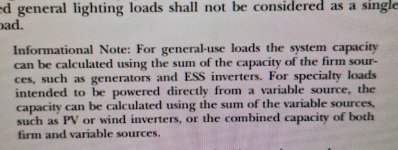Pressure
Member
- Location
- Lawrence, KS
- Occupation
- Design Engineer
If you read this code then you can assume that If you have a PV System tied to a BESS, then the combined output rating need only be as large as the single largest load posed in the system to be backed up in a stand-alone situation.
I am faced with designing a system that has an EV charger as its largest load. A 60A 2P that is likely pulling the full 48A continuously. Now if I use the rating of the two BESS units then I have 41.66A of continuous output, and have not met the requirements of 710.15(A). But if I add my PV of 39.15A, then I have a total stand-alone system size of 80.81A, and have met the requirements of 710.15(A). My personal opinion is that I should not count the PV. Even though the NEC says I can. There could be multiple times when the system is in stand-alone operation at night, when PV is not available, and the true output is 41.66A. At that point the charging of the vehicle would kill the system.
Has anyone faced this challenge in system design? Are there any clarifications to this rule? I want to have a discussion about how this rule could be abused to make poor designs for Stand-Alone Systems.
I am faced with designing a system that has an EV charger as its largest load. A 60A 2P that is likely pulling the full 48A continuously. Now if I use the rating of the two BESS units then I have 41.66A of continuous output, and have not met the requirements of 710.15(A). But if I add my PV of 39.15A, then I have a total stand-alone system size of 80.81A, and have met the requirements of 710.15(A). My personal opinion is that I should not count the PV. Even though the NEC says I can. There could be multiple times when the system is in stand-alone operation at night, when PV is not available, and the true output is 41.66A. At that point the charging of the vehicle would kill the system.
Has anyone faced this challenge in system design? Are there any clarifications to this rule? I want to have a discussion about how this rule could be abused to make poor designs for Stand-Alone Systems.

